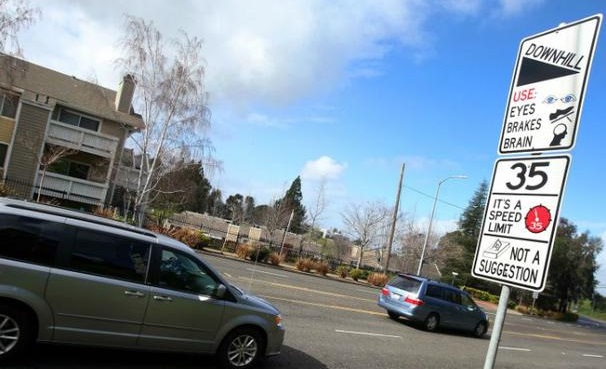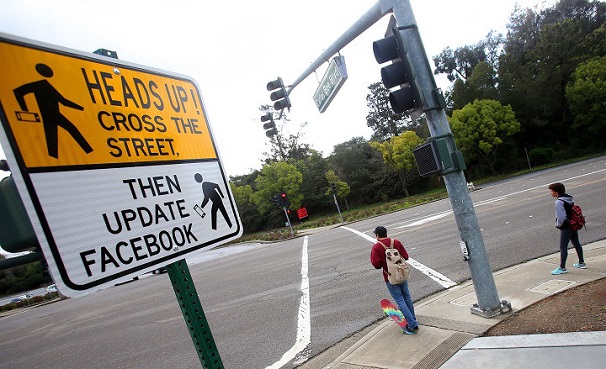
We at Label Source would like to applaud the American city of Hayward, California, who have taken a rather novel approach to road safety. One can only assume that Hayward's residents weren't paying enough attention to the usual traffic signs, because one main road is now dotted with a slightly more unusual breed of signage:
"35 - It's a speed limit, not a suggestion!"
Downhill - Use: Eyes, Brakes, Brain"
Frank Holland, speaking on behalf of the city, said: "The idea is for people to do a double take and then realize, 'Oh, they want me to be careful on the hill. Standard traffic signs often become white noise...we wanted to use humour to get people to take a second look and think."
It's a great idea, and Hayward's attention-grabbing ploy seems to have worked - not only are residents paying more attention to the signs, the signs have actually made international news!
And motorists aren't the only targets of these humorous signs. They've got one for pedestrians, too:

The British public (sometimes justifiably) have very little patience for health and safety measures, and we think it would be fantastic if local councils took a leaf from Hayward's book and started using a bit of humour - it is a great way to capture people's attention and ensure that hazards don't go ignored.
It's important, though, to note that Hayward's rib-tickling signs aren't enough on their own; one local resident admitted that the signs were "cool", but added that "it's hard to see the speed limit". Hayward haven't replaced their standard road safety signs with the ones in these photos; they've just supplemented them with something fun and light-hearted. Both are important!
Photos: Aric Crabb/Bay Area News Group
The Provision and Use of Work Equipment Regulations 1998 (PUWER) requires work equipment and plant to be maintained so it remais safe and the maintenance operation is carried out safely.
Maintenance of plant and equipment in an industrial factiory is carried out to prevent any problems from arising, to put faults right and to ensure any equipment is working effectively. Plant maintenance usually refers to the strategies, methods and practices used to keep an industrial factory running smoothly. Plant maintenance can include anything from regular checks of equipment to make sure they function properly to even making sure rubbish bins and toilets are cleaned properly. Mainenance may be part of a planned programme or may have to be carried out at short notice after a breakdown. It always involves non-routine activities and can expose those involved (and others) to a range of risks.
Plant Maintenance Labels
The primary aim of plant maintenance is to create a productive working environment that is also safe for workers and any visitors to the plant. A successful maintenance programme will make both plant and equipment more reliable. Fewer breakdwons will mean less dangerous contact with machinery is required, as well as providing better productivity and efficiency and consequently lowering costs.
Plant Maintenance and Electrical Tags
Label Source offers a variety of Plant Maintenance Signs, Labels and Tags, all of which can be used in the maintenance of industrial premises and the associated equipment, machinery, fittings, fixtures, instruments and tools. Our range of plant maintenance products alert users, machine operators and any service personell of rsisk or dangers associated with using the equipment in the plant. We also supply a range of maintenance labels that can be used to assist in the regular inspection and servicing of your machinery.

Electrical Maintenance Safety Signs
If you can't find the Plant Maintenance labels that you are looking for, or if you simply wish to discuss some of our plant maintenance products then call Label Source on 0800 3761 693 from the UK, or 0044 1443 842769 if you're calling from abroad.
Plant Maintenance Equipment Labels
Chemical spills can have serious, and sometimes devastating, consequences including human health issues, environmental pollution, structural building damage or contamination, and threats to corporate image and reputation.
Emergency procedures should be in place to provide a safe response by trained teams of staff, contractors or emergency services, using appropriate personal protective equipment to tackle any leak or seepage of dangerous substances or hazardous chemicals.

Our range of chemical hazard warning signs can be used to identify the type of risk posed by such chemicals including toxicity, flammability, explosion or corrosion. Thus, the risks can be assessed from chemical contact with skin or eyes, causing irritation or burns, or from internal injuries caused by inhalation or ingestion. The personal protective equipment, such as gloves, goggles, clothing and respirators should be used before tackling any spill, and first aid should be available to treat any contaminated personnel.
Our spill kit signs can be used to provide contact details for spill supervisors, and the emergency services. These cover different types of chemicals; non-aggressive fluids and oil or fuel (on land); oil or fuel on land and water; and aggressive fluids such as acids and alkalis. They cover the types of containment and neutralising agents for dispersal and disposal. One key task is to prevent chemical release to the atmosphere, water course or to soil. Spill areas can be cordoned off using our barrier tapes to prevent other workers or the general public from entry.
In addition, our dangerous substance storage containment signs can itemise chemicals, waste and any special waste, to allow emergency staff to assess the immediate risks.
As of late, the health and safety culture has come under fire from a number of angles due to some rather questionable 'health and safety' stories making the national press. Indeed, over the past few months the papers have been full of peculiar decisions by businesses which are reportedly due to health and safety - including Newcastle racecourse banning picnics due to visitors' chairs supposedly presenting a health and safety issue. Similarly, it was reported that factory workers in Plymouth were left in tears after their wedding rings were cut off due to health and safety.

To many, these decisions seem unfair, unjust and perhaps even a little bit silly. Many have spoken out about how our health and safety culture has 'gone mad' or is 'ruining childhood'. The truth is, however, that it isn't the health and safety culture which has run amok - rather, it is the businesses who are willing to use health and safety as an excuse for their decisions. The health and safety blame game has developed in such a way that the Health and Safety Executive (HSE) has developed a myth-busting panel who will independently challenge advice or decisions supposedly made in the name of health and safety they believe to be inaccurate or disproportionate.
Indeed, the HSE Myth Busters have spoken out about some ludicrous decisions made in the name of health and safety - including the Newcastle racecourse example we mentioned at the beginning of this blog - condemning these decisions, and stating that in fact these decisions have not been made in the name of health and safety.
As well as being damaging to the HSE's reputation, the health and safety blame game also presents us with a further problem with regards to health and safety itself. Blaming business decisions on health and safety is extremely damaging to health and safety as a whole; there are health and safety rules and legislations for any business and indeed almost any public place, and the rules are in place to save lives, protect safety and minimise any risk. It is vital that health and safety legislations are respected and followed - otherwise, we could be at risk of an increase in accidents and, potentially, fatalities.
Purchase your Safety Signs to make sure your place of work is complying with the health and safety legislations here.
COSHH stands for Control Of Substances Hazardous to Health. COSHH is a set of regulations that, since 2002, has governed the use of hazardous substances and chemicals in the UK.
The regulations were put into place so as to protect workers and other people from potentially dangerous substances. They state that employers must not expose their staff to such substances without first carrying out a risk assessment and taking steps to minimise the danger.
This can mean making changes that will make the substances themselves safer (e.g. using solids rather than liquids to prevent splashes and spills), but it also means identifying and labelling hazards so that everyone is aware of them.
This should be achieved through the use of COSHH-approved signs and tapes, which are specifically designed to effectively warn of substance-related dangers. These clearly marked and highly visible warning products can alert workers to a variety of hazards, including:
- Flammable goods
- Toxic substances
- Corrosives and irritants
- Biohazards
- Radioactive materials
COSHH signs should also be used to...
- ...remind workers of the appropriate precautions (e.g. keeping doors shut)
- ...advise the use of PPE
- ...warn of the presence of hazardous substances
- ...give additional information on the safe use of these substances
The COSHH regulations are designed to keep you, your employees, and everyone around you safe. Please visit the HSE website for further details, or select one of the links below to see our range of COSHH safety products.